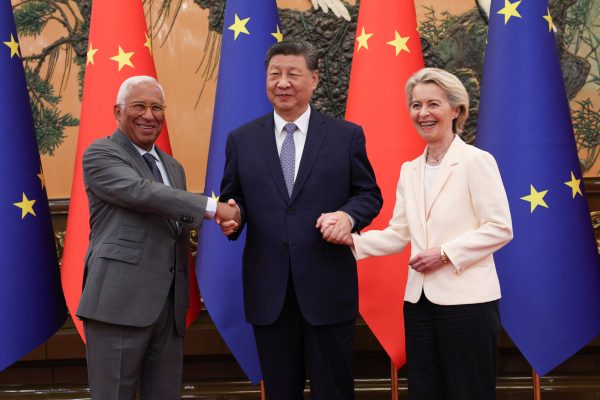By Stefan Messingschlager
Copyright thediplomat

Europe’s China debate has moved from abstractions to leverage. In the space of a year, Brussels imposed steep countervailing duties on subsidized Chinese electric vehicles (EVs) while Beijing tightened export controls on the minerals that make those cars move. What once passed for risk-free globalization now looks like a contest over chokepoints, standards, and time. The premise that commerce would pacify politics has given way to a sharper reality: interdependence is power, and it can be used. That shift is unmistakable in the EV case and in the curbs on gallium, germanium, and graphite that roiled supply chains across clean tech and chips. This feature makes a simple claim. Western – especially European – China policy faltered less because engagement was wrong than because it was pursued with naïve assumptions, short horizons, and fragmented execution, while Beijing played a long, sovereignty-first game. The cure is not decoupling or moral grandstanding, but managed interdependence: map and reduce single-point vulnerabilities, protect a narrow slice of dual-use technology with allies, and keep doors open where global goods require cooperation. The European Union has already adjusted its vocabulary – from the 2019 Strategic Outlook that labeled China a partner, competitor, and systemic rival to the 2023 line of “de-risking, not decoupling.” The question now is whether Europe can turn words into habits. When Trade Became Leverage For years, the relationship was narrated as mutual gain: lower prices, larger markets, faster diffusion of clean technologies. The past two years punctured that comfort. The European Union moved from warnings to weapons, imposing definitive duties on Chinese-built electric vehicles after finding pervasive state support. Beijing did not leave the signal unanswered. It opened investigations into emblematic European exports, levied duties in politically salient sectors, and kept WTO avenues warm. The result was less a rupture than a stress test: interdependence, when asymmetric, becomes leverage. Minerals brought the point home. When Beijing required licenses for exports of gallium and germanium – metals essential to semiconductors and defense systems – international shipments effectively dried up for months; later, controls were widened to graphite, a critical input for battery anodes. Prices spiked, procurement officers scrambled, and a lesson reasserted itself: efficiency without optionality becomes fragility. In Europe’s capitals, the conclusion finally stuck: de-risking is not a slogan but a supply-chain discipline. The political-economy literature has a term for this dynamic – weaponized interdependence – but the practical imperative is plainer: rebuild optionality at the nodes that matter, and do so in concert with partners so that backdoors do not reopen as soon as one door is closed. How Europe’s Playbook Went Wrong The first error was conceptual. For three decades, many Western leaders wagered that deeper economic ties would nudge China toward political convergence and rule-of-law alignment – the creed of “change through trade.” By 2019, the European Commission had to say out loud what practice already showed: China is at once partner, competitor, and systemic rival, and reciprocity cannot be assumed. That recognition came late, but it clarified terms: engagement would continue, yet it could no longer be mistaken for a strategy of transformation. The second error was temporal. China plans in five-year cycles and decades; Europe too often plans by quarter and electoral calendar. Beijing’s push for indigenous capacity – from “dual circulation” to targeted industrial policies – was not a bargaining chip to be traded away later but a structural course aimed at resilience at home and leverage abroad. Europe, by contrast, tended to outsource foresight to the market until crises forced improvisation. The result was an asymmetry of preparation: when shocks hit, policy lurched; when opportunities arose, coordination lagged. The third error was structural. Fragmentation inside Europe invited divide-and-rule tactics and dulled instruments when they were needed most. National export drives and solo messaging undercut common positions; sensitive files ping-ponged between ministries with different risk tolerances. When one member state faced coercion, collective responses were slow to gel. The EU has since equipped itself with a legal shield – the Anti-Coercion Instrument – that authorizes calibrated, union-wide countermeasures when a third country uses economic pressure to force policy change. Used sparingly but credibly, it deters tests of the weakest link. Communication missteps compounded the damage. Western rhetoric sometimes oscillated between moral thunder and commercial courtship, making it easy for Beijing to recast criticism as hypocrisy. The corrective is not silence but discipline: argue from specific rules, keep the tone professional, and link words to actions. The mantra “de-risking, not decoupling” was coined to lower the temperature – an explicit rejection of economic blocs – but consistency matters more than terminology. If Europe says it is not decoupling, policy must reflect it even as security guardrails tighten. A Realistic Reset: De-Risk, Coordinate, Compete EU policy must start with ends-and-means realism. The goal is not to transform China but to secure durable coexistence on fair terms. That implies a narrow focus on where politics and technology intersect: reduce single-point dependencies that can be weaponized, protect a thin slice of dual-use capabilities at the frontier, and insist on reciprocity and predictability in market access. Anything broader will dissipate political capital and drift into gesture. De-risking begins with a map, not a mantra. Governments and firms need a shared view of exposures in critical minerals, active pharmaceutical ingredients, power electronics, machine tools, and telecoms. For each node, there are three levers: diversify by developing second and third suppliers across allied jurisdictions (including at home where sensible); buffer by maintaining strategic stockpiles for inputs that cannot be substituted quickly; redesign by engineering products and processes to eliminate single points of failure. The honest test of success is measurable: falling single-supplier shares, faster recovery times under disruption scenarios, and fewer policy concessions extracted under duress. Europe also needs tools that fit the problem. Trade defenses and export controls have their place, but they cannot substitute for capacity. Defensive walls without productive depth are Maginot lines. That means patient capital for scale in batteries, semiconductors, and clean-tech equipment; faster permitting for strategic manufacturing; standards leadership that rewards transparency and sustainability; and procurement that creates first markets for European innovators. The aim is not autarky; it is portfolio resilience. Coordination multiplies leverage. No single European capital can set incentives for a continental rival; the European Union can. Europeanize the files that count – screening inbound and outbound investment, baselines for critical infrastructure, and watchlists for sensitive technologies – and move national timelines in lockstep so gaps cannot be gamed. Use the Anti-Coercion Instrument with clear criteria and rehearsed playbooks that turn declarations into action within weeks, not months. When one member is squeezed, the others must make it boring for would-be coercers to try again. Coalitions should be minilateral and mission-driven rather than doctrinal. On semiconductors, align export rules and guardrails with the United States, Japan, South Korea, the Netherlands, and Taiwan to close back doors while avoiding subsidy races. On minerals, pool finance with Australia, Canada, and partners in Africa and Latin America to underwrite extraction, processing, and recycling outside concentrated jurisdictions. In the Indo-Pacific, contribute where Europe adds real value – maritime domain awareness, standards, and financing that keeps options open for smaller states – without forcing binary choices. The EV confrontation is easily caricatured as protectionism. It is better read as rules enforcement and time-buying: a response to evidence of state support across the value chain and a bridge for Europe to scale its own capacity while insisting on reciprocity. If Beijing answers with lawful countermeasures, that is the system working; if it leans on coercion, the case for collective instruments only strengthens. Either way, clarity beats drift, and predictable processes beat ad hoc bargains. Tone is not cosmetic; it is part of the strategy. Speak with respect about China’s history and society; anchor critique in treaty commitments; move the hardest messages off the podium and into the room; and pair any public warning with a concrete, proportionate step. This is the inverse of performative rhetoric. It is also the register most likely to persuade third countries that Europe is serious, predictable, and not in the business of exporting insecurity. Properly done, de-risking is an offer of options, not a demand for alignment. Finally, invest in China literacy and feedback loops. Governments need more Mandarin-capable analysts and political-economy specialists embedded not only in foreign ministries but in economics, technology, health, and transport portfolios. Regular red-team reviews should interrogate major China-exposed decisions before they are made; after each episode – sanctions, disputes, coercion – lessons-learned processes should tighten playbooks. Companies, for their part, should disclose concentration risks, rehearse contingency plans, and coordinate with allies’ authorities so that private adaptation and public policy reinforce each other. Governance matters as much as intent. Publish an annual dependency scorecard that lists the top exposures by sector and tracks year-on-year change; run regular disruption exercises – what happens if graphite or specific API flows stop for 90 days? – and publish the remedial timelines. Tie public finance to measurable diversification targets rather than to press-friendly announcements. The more Europe can substitute dashboards for slogans, the less room there is for wishful thinking or panic. Competitiveness is the hinge that turns defensive measures into durable leverage. Europe will not persuade firms to diversify, nor partners to align, if it cannot offer scale, speed, and skilled people. That argues for missions that marry research, training, and deployment – battery supply chains that integrate chemists with electricians, semiconductor programs that link design houses to fabs and toolmakers, grid upgrades that turn renewables into reliable baseload. It also argues for clean, predictable permitting and for procurement that rewards resilience attributes – redundancy, transparency, recycling – rather than the lowest upfront price alone. Security-relevant supply chains are public goods; treating them as such will cost money now and save money later. Boundaries Without Blocs A reset premised on calm realism draws three lines. First, it treats interdependence as a condition to manage, not a fate to endure. That means publishing dependency scorecards and disruption scenarios, then governing the data rather than the news cycle. Second, it separates tone from tools – cool language, firm measures – so neither domestic politics nor propaganda traps dictate policy tempo. Third, it keeps doors open where global goods hinge on Chinese participation – climate, health security, and debt sustainability – while making responsibilities and consequences explicit. This posture is harder than slogans, and slower. It asks Europeans to accept upfront costs – redundancy, inventories, diversification – in exchange for fewer crises and less coercion later. It asks politicians to resist the lure of one-off deals that splinter common positions. And it asks partners to move together often enough that arbitrage becomes tedious. Yet the alternative is drift: a politics of reflex and surprise shaped by decisions made elsewhere. The lesson of recent years is that strategy beats hope – and that clarity, sustained over time, changes incentives. Avoiding escalation requires two habits. One is to separate tone from tools: keep the language measured, make the instruments real. The other is to offer off-ramps: when Beijing moderates on an issue – say, debt workouts or methane reporting – respond with visible reciprocity, even if modest. Incentives matter. A pathway that rewards restraint and deters coercion is more sustainable than a posture that turns every disagreement into a test of wills. Europe’s China reset will succeed if it becomes a habit. That habit looks like unity instead of freelancing; diversification instead of single points of failure; precision instead of maximalism; and quiet resolve instead of outrage. The relationships that matter most – in Asia, in the transatlantic space, and across the wider Global South – will judge Europe not by its adjectives but by its follow-through. Respect where possible, firmness where necessary, and solidarity as routine rather than headline: that is the essence of calm realism.



